Projects
Improving the workplace
The Centre for Advanced Training Systems (ATS) activities are funded on a project-specific basis and to date, have focused on improving workplace training.
We have worked across several industries including Defence, Healthcare, Education, First Responder and Agriculture. Some examples of the type of projects and partners we have engaged with include:
Training Systems Development
- The design development of Performance Edge VR stress management training with the Australian Defence Force
- The design development and evaluation of TACTICS VR hyper-acute clinical training with the Agency of Clinical Innovation and NSW Ambulance.
Training Systems Evaluation and Optimization
- Review of Psychological Injury Management Best Practices for QBE Insurance, in collaboration with the Centre for Rehab Innovations (University of Newcastle).
- Comparative evaluation of development, procurement and management of virtual reality based training for tertiary education.
- Australian Livestock Export Corporation – Animal Welfare – in collaboration with University of West Australia and University of Queensland.
- Review of Training Systems for NSW Health Pathology Point of Care Testing
- Evaluation of immersive free roam virtual reality-based training, in collaboration with the Army Headquarters and 3rd Brigade.
- Design and evaluation of immersive training with Victoria Police.
- Design and evaluation of immersive training with New Zealand Police College
- ATS collaborated with the Defence Intelligence Training Centre (DINTTC) and Special Air Service Regiment (SASR) on Psychological Stress.
- ATS worked with the Maritime Warfare Centre to deliver a Red Teaming Practitioners Course.
- ATS worked with the Australian Defence College to develop a back casting facilitators guide and provide provide input and feedback on the Joint Professional Military Education Curriculum 2.0.
Training Systems Research
- ATS contributed to a Defence Science and Technology Group (DSTG) sponsored Delphi review to examine the critical psychological and neurocognitive drivers of high performance across different occupations.
- ATS worked with the Royal Australian Air Force (RAAF) Tower and Air Traffic Control to identify novel strategies for sensing cognitive load and with RAAF Staff in Aviation Medicine to consider the impact of training on the ability to identify and respond to Hypoxia.
- ATS partnered with the Combat Training Centre to develop cognitive training for controllers operating in Command and Control (C2) environments.
- ATS partnered with Griffith (Dr Matt Steiner and Dr Karen Murphy) and James Cook (Prof Mick Reilly) University in a Command and Control Human Performance Research Consortia.
Further project specific information can be found below:
Latest News
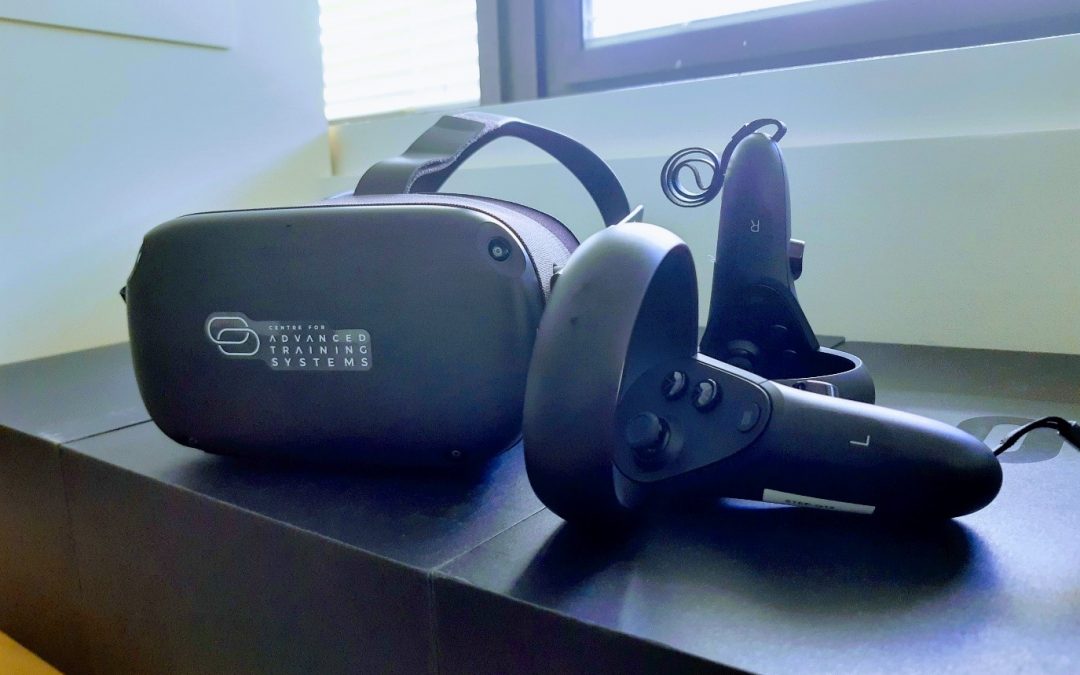
Deploying XR Teaching and Learning Tools into University Classrooms
2018 was a life time ago! In 2018, the Centre for Advanced Training Systems (ATS) began early discussions with then newly appointed and highly energised Professor Darrell Evans, Deputy Vice Chancellor Academic at University of Newcastle. Darrell was energised and...
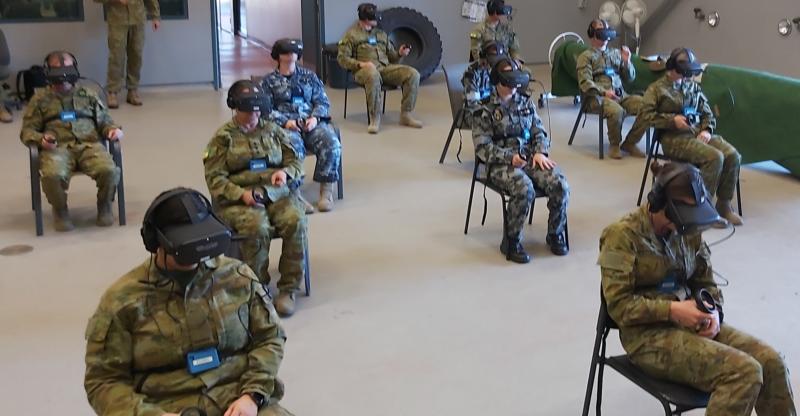
Transforming Stress Management Training for the Australian Defence Force
The Centre for Advanced Training Systems (University of Newcastle) has had the privilege of co-designing a comprehensive virtually reality based stress management training platform with the Australia Defence Force (ADF). The platform, supported by the Defence...
Health Projects
Tactics VR - Streamlined workflow management for acute stroke care
|
Project Name: VR-based Training in Management of Acute Stroke Project Overview: This study aims to evaluate the effectiveness of virtual reality to support healthcare staff training in a clinical setting. The initial module was part of a “package intervention” aimed at providing better access for patients in remote areas to reperfusion therapies following acute stroke. As part of this study, ATS developed and implemented a VR training tool to be deployed to junior medical officers, to train them in the optimal processing of an acute stroke patient coming to hospital. To learn more about the studies, access the publications listed below. The VR training tool offers an immersive environment where users are taken through a virtual stroke patient’s journey. The program includes video commentary by experts, assisted collection of relevant information, evaluation of representative imaging and treatment decision-making and support, as well as feedback on user performance to enhance learning experience. Beyond the VR module, we have developed a comprehensive training environment. This includes a supporting website and reporting environment, with access to instructions and additional resources and automated capture of VR usage and user performance. Building on the success of the first VR module, additional modules have been developed to support stroke telehealth and stroke nursing education, in partnership with NSW Agency for Clinical Innovation. A further module is in development for pre-hospital stroke management training in collaboration with NSW Ambulance. Access an informational video here: https://youtu.be/aBxflPYmW_M Collaborator / Partners / Funding:
Primary ATS Project Officer(s) & Contact:
Relevant Links: |
|
|
Paediatric Distraction Tool – Virtual reality to reduce pain relief treatment in children
|
Project Name: Paediatric Distraction Therapy Project Overview: This project aims to implement VR as a distraction therapy for children undergoing painful injections. Nobody likes injections, especially children. Many parents will tell you that the routine immunization visits are an unpleasant affair. This multiplies when a child has numerous medical conditions, has difficulties in many aspects of their daily life and must receive painful intramuscular injections as part of their rehabilitative care. VR can effectively reduce pain in a range of medical procedures. Dr Timothy Scott (HNE KidsRehab) highlighted the need for additional, non-pharmacological analgesic options for paediatric patients at the John Hunter Children’s Hospital botox injection clinic. He proposed that VR technology may provide better patient health outcomes. The Centre for Advanced Training Systems (ATS) have formed a collaborative alliance with the clinical team, with the common goal of co-designing and implementing VR as a distraction therapy for this patient group. Collaborator / Partners / Funding:
Primary ATS Project Officer(s) & Contact:
|
|
Cybersickness - Uncovering mechanisms and developing treatments for motion sickness
|
Project Name: Biomarkers of Cybersickness Project Overview: Cybersickness is a subtype of motion sickness caused by exposure to provocative VR content (e.g. content mimicking significant accelerations). We performed detailed clinical and physiological assessment of cybersickness using a virtual rollercoaster scenario (see image). The majority of our volunteers requested to terminate the ride in less than 10 minutes. We also performed the first direct comparison study of cybersickness with motion-induced motion sickness; reporting that in both instances nausea is accompanied by a selective increase of sweating on the forehead region. Using near-infrared spectroscopy (NIRS), we also found that cybersickness is associated with dramatic changes in brain blood flow (haemodynamics). In collaboration with Otolith Labs, a US-based start-up company, we are now testing an innovative wearable device to prevent motion sickness through non-invasive Vestibular System Masking. Collaborator / Partners / Funding:
Primary ATS Project Officer(s) & Contact:
Relevant Links: |
An image of VR content used in our studies https://www.youtube.com/watch?v=PUtHvzNTTNo
An example of physiological recordings obtained during the VR simulated ride on a rollervoaster . Traces (from top to bottom): heart rate, respiratory signal, respiratory rate, finger skin conductance level (SCL) tonic, finger SCL phasic, forehead SCL tonic, forehead SCL phasic. The first and the last vertical lines indicate the start and the end of virtual ride, respectively. Numbers above other lines indicate nausea level experienced by the subjects. Note that changes in HR and respiration are rather minor, and clearly associated with arousal/excitement associated with ride onset but not nausea. Finger SCL rise is substantial but is also arousal-related. In contrast, SCL in the forehead does not increase until moderate nausea is developed. (From Gavgani et al. Profiling subjective symptoms and autonomic changes associated with cybersickness. Auton Neurosci 2017) |
Exposure Therapy - Monitoring virtual reality exposure treatment of phobias
|
Project Name: VRET: Virtual Reality Exposure Therapy Project Overview: Virtual reality exposure therapy (VRET) has gained popularity as an efficient and cost-effective treatment for a variety of fears and phobias. Project lead Dr Jill Newby is a highly experienced clinical psychologist with broad expertise in technology-based interventions for mental health disorders. She currently trials VRET in patients with acrophobia (fear of heights) by exposing them to 360-degree videos containing provocative content (e.g. video on the Westfield Sydney Tower observation floor – see link). Our collaboration aims to supplement VRET with objective measurements of physiological arousal. We hypothesise that in susceptible individuals, provocative content elicits substantial increases in heart rate, respiratory rate and skin conductance. We expect that repetitive VR exposure will lead to the reduction of these responses, and thus biomarker monitoring may be useful for objective assessment of VRET progress. Collaborator / Partners / Funding:
Primary ATS Project Officer(s) & Contact:
Relevant Links: |
Screenshot from Sydney Tower 360 video |
Health Projects
Tactics VR - Streamlined workflow management for acute stroke care
Project Name: VR-based Training in Management of Acute Stroke
Project Overview: This study aims to evaluate the effectiveness of virtual reality to support healthcare staff training in a clinical setting. The initial module was part of a “package intervention” aimed at providing better access for patients in remote areas to reperfusion therapies following acute stroke. As part of this study, ATS developed and implemented a VR training tool to be deployed to junior medical officers, to train them in the optimal processing of an acute stroke patient coming to hospital. To learn more about the studies, access the publications listed below.
The VR training tool offers an immersive environment where users are taken through a virtual stroke patient’s journey. The program includes video commentary by experts, assisted collection of relevant information, evaluation of representative imaging and treatment decision-making and support, as well as feedback on user performance to enhance learning experience.
Beyond the VR module, we have developed a comprehensive training environment. This includes a supporting website and reporting environment, with access to instructions and additional resources and automated capture of VR usage and user performance.
Building on the success of the first VR module, additional modules have been developed to support stroke telehealth and stroke nursing education, in partnership with NSW Agency for Clinical Innovation. A further module is in development for pre-hospital stroke management training in collaboration with NSW Ambulance.
Collaborator / Partners / Funding:
- Hunter New England Health District TACTICS trial study team led by:
- NHMRC-funded Partnership Grant
- NSW Agency for Clinical Innovation
- Hunter New England Local Health District Telehealth Initiative
Primary ATS Project Officer(s) & Contact:
- Dr. Steven Maltby (Steven.Maltby@Newcastle.edu.au)
- Dr. Rebecca Hood (Rebecca.hood@Newcastle.edu.au)
- Dr. Angela Keynes (Angela.Keynes@Newcastle.edu.au)
Relevant Links:
- TACTICS Trial Protocol Publication (BMJ Open 2022)
- TACTICS VR Publication (Frontiers in Neurology 2021)
- NSW Health Agency for Clinical Innovation Clinician Connect (Sept 2021)
- Newcastle Herald Feature
- TACTICS VR Supporting Website
- TACTICS VR Website
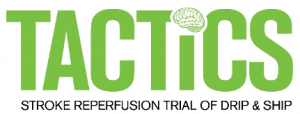
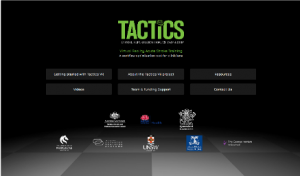
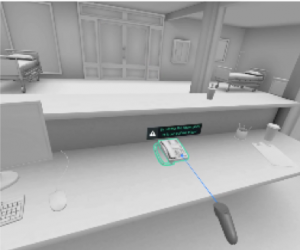
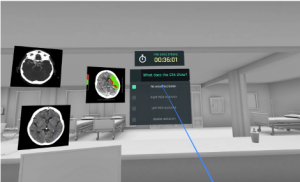
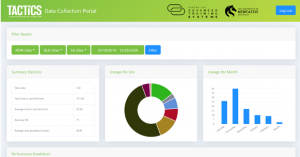
Paediatric Distraction Tool – Virtual reality to reduce pain relief treatment in children
Project Name: Paediatric Distraction Therapy
Project Overview: This project aims to implement VR as a distraction therapy for children undergoing painful injections.
Nobody likes injections, especially children. Many parents will tell you that the routine immunization visits are an unpleasant affair. This multiplies when a child has numerous medical conditions, has difficulties in many aspects of their daily life and must receive painful intramuscular injections as part of their rehabilitative care.
VR can effectively reduce pain in a range of medical procedures. Dr Timothy Scott (HNE KidsRehab) highlighted the need for additional, non-pharmacological analgesic options for paediatric patients at the John Hunter Children’s Hospital botox injection clinic. He proposed that VR technology may provide better patient health outcomes. The Centre for Advanced Training Systems (ATS) have formed a collaborative alliance with the clinical team, with the common goal of co-designing and implementing VR as a distraction therapy for this patient group.
Collaborator / Partners / Funding:
- Hunter New England Health District Kids Rehab Services
- Dr. Timothy Scott (HNEkidsRehab)
Primary ATS Project Officer(s) & Contact:
- Dr. Angela Keynes (Angela.Keynes@Newcastle.edu.au)

Cybersickness - Uncovering mechanisms and developing treatments for motion sickness
Project Name: Biomarkers of Cybersickness
Project Overview: Cybersickness is a subtype of motion sickness caused by exposure to provocative VR content (e.g. content mimicking significant accelerations). We performed detailed clinical and physiological assessment of cybersickness using a virtual rollercoaster scenario (see image). The majority of our volunteers requested to terminate the ride in less than 10 minutes. We also performed the first direct comparison study of cybersickness with motion-induced motion sickness; reporting that in both instances nausea is accompanied by a selective increase of sweating on the forehead region (link). Using near-infrared spectroscopy (NIRS), we also found that cybersickness is associated with dramatic changes in brain blood flow (haemodynamics).
In collaboration with Otolith Labs, a US-based start-up company, we are now testing an innovative wearable device to prevent motion sickness through non-invasive Vestibular System Masking.
Collaborator / Partners / Funding:
- The University of Newcastle
- Global Connections Fund (funding)
Primary ATS Project Officer(s) & Contact:
- A/Prof Eugene Nalivaiko (Eugene.Nalivaiko@newcastle.edu.au)
Relevant Links:
- https://www.ncbi.nlm.nih.gov/pubmed/26340855
- https://www.ncbi.nlm.nih.gov/pubmed/28010995
- https://www.ncbi.nlm.nih.gov/pubmed/28777827
- https://www.ncbi.nlm.nih.gov/pubmed/29649509
- https://www.ncbi.nlm.nih.gov/pubmed/30284516
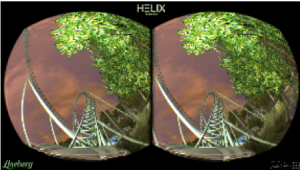
An image of VR content used in our studies https://www.youtube.com/watch?v=PUtHvzNTTNo
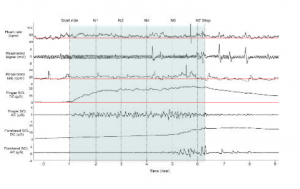
An example of physiological recordings obtained during the VR simulated ride on a rollervoaster . Traces (from top to bottom): heart rate, respiratory signal, respiratory rate, finger skin conductance level (SCL) tonic, finger SCL phasic, forehead SCL tonic, forehead SCL phasic. The first and the last vertical lines indicate the start and the end of virtual ride, respectively. Numbers above other lines indicate nausea level experienced by the subjects. Note that changes in HR and respiration are rather minor, and clearly associated with arousal/excitement associated with ride onset but not nausea. Finger SCL rise is substantial but is also arousal-related. In contrast, SCL in the forehead does not increase until moderate nausea is developed. (From Gavgani et al. Profiling subjective symptoms and autonomic changes associated with cybersickness. Auton Neurosci 2017)
Exposure Therapy - Monitoring virtual reality exposure treatment of phobias
Project Name: VRET: Virtual Reality Exposure Therapy
Project Overview: Virtual reality exposure therapy (VRET) has gained popularity as an efficient and cost-effective treatment for a variety of fears and phobias. Project lead Dr Jill Newby is a highly experienced clinical psychologist with broad expertise in technology-based interventions for mental health disorders. She currently trials VRET in patients with acrophobia (fear of heights) by exposing them to 360-degree videos containing provocative content (e.g. video on the Westfield Sydney Tower observation floor – see link).
Our collaboration aims to supplement VRET with objective measurements of physiological arousal. We hypothesise that in susceptible individuals, provocative content elicits substantial increases in heart rate, respiratory rate and skin conductance. We expect that repetitive VR exposure will lead to the reduction of these responses, and thus biomarker monitoring may be useful for objective assessment of VRET progress.
Collaborator / Partners / Funding:
- Dr Jill M. Newby (School of Psychology, University of New South Wales)
- Medical Research Future Fund (MRFF) – funding
Primary ATS Project Officer(s) & Contact:
- A/Prof Eugene Nalivaiko (Eugene.Nalivaiko@newcastle.edu.au)
- Dr Jill M. Newby (j.newby@unsw.edu.au)
Relevant Links:
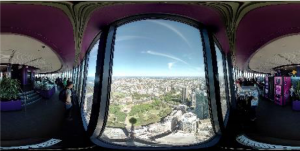
Screenshot from Sydney Tower 360 video
Education Projects
Step - Tailored development and evaluation of new VR teaching tools across multiple University of Newcastle courses
|
Project Name: Digital Simulation Technology Evaluation Program (STEP) Project Overview: STEP is a University-wide program and a key initiative of the NEW Education Framework assessing the potential of mixed-reality (XR) technologies as a scalable teaching resource within the university. The Program includes multiple lines of activity to address questions on how to integrate XR technologies in future curriculum at The University of Newcastle (UON):
Data obtained collectively from these activities will inform the development of a structured business plan on how XR technology can be integrated and used in the future at UoN and findings will be reported through academic publications. Collaborator / Partners / Funding:
Primary ATS Project Officer(s) & Contact:
Relevant Links: |
 |
Cultural Burn VR - Increasing awareness of cultural burning practices
|
Project Name: Cultural Burning – Development of a Virtual Reality-Based Education Application Project Overview: Local Land Services NSW has long been passionate about supporting Aboriginal people to care for Country through Aboriginal Elders sharing their traditional land management and ecological knowledge with the younger members of their community. Senior Land Service Officer Toby Whaleboat (Local Land Services NSW) approached the ATS with a vision to increase awareness and create a deeper understanding of one such aspect; cultural burning. Cultural burning describes the traditional Aboriginal practice of using burning methods to improve the health of the land and its people. It can include burning or the prevention of burning to improve the health of specific native plants and animals in bushland. The significant effects of bushfires and the need for improved land management approaches have been highlighted by recent catastrophic bushfire events. Thus, there is an interest in developing educational content to increase awareness of traditional cultural burning practices for a range of audiences. A virtual reality (VR)-based application using 360o video is being co-developed to address this need as a collaboration between ATS and Local Land Services NSW. The resulting application will provide user immersion into bushland sites and provide educational information about cultural burning. Collaborator / Partners / Funding Primary ATS Project Officer & Contact:
Relevant Links: |
 |
Education Projects
Step - Tailored development and evaluation of new VR teaching tools across multiple University of Newcastle courses
Project Name: Digital Simulation Technology Evaluation Program (STEP)
Project Overview: STEP is a University-wide program and a key initiative of the NEW Education Framework assessing the potential of mixed-reality (XR) technologies as a scalable teaching resource within the university. The Program includes multiple lines of activity to address questions on how to integrate XR technologies in future curriculum at The University of Newcastle (UON):
- Capturing general wants, needs, values, concerns and barriers of the technology via a student- and staff-wide general attitude survey
- Learning from existing XR teaching applications via interviews with ‘early-adopter’ teaching staff involved in the creation of existing applications
- Bringing together a community of practise and encouraging open communications and exchange through the “Virtual Reality in Teaching” symposium
- Developing a comprehensive cost-benefit analysis on the use of XR as a teaching tool, through the design, development and implementation of 4 pilot XR teaching applications across diverse UoN degree programs
Data obtained collectively from these activities will inform the development of a structured business plan on how XR technology can be integrated and used in the future at UoN and findings will be reported through academic publications.
Collaborator / Partners / Funding:
- The University of Newcastle– Deputy Vice-Chancellor Academic (DVC-A) – funding
Primary ATS Project Officer(s) & Contact:
- Dr. Murielle Kluge (Murielle.Kluge@Newcastle.edu.au)
- Dr. Steven Maltby (Steven.Maltby@newcastle.edu.au)

Cultural Burn VR - Increasing awarness of cultural burning practices
Project Name: Cultural Burning – Development of a Virtual Reality-Based Education Application
Project Overview:
Local Land Services NSW has long been passionate about supporting Aboriginal people to care for Country through Aboriginal Elders sharing their traditional land management and ecological knowledge with the younger members of their community. Senior Land Service Officer Toby Whaleboat (Local Land Services NSW) approached the ATS with a vision to increase awareness and create a deeper understanding of one such aspect; cultural burning.
Cultural burning describes the traditional Aboriginal practice of using burning methods to improve the health of the land and its people. It can include burning or the prevention of burning to improve the health of specific native plants and animals in bushland. The significant effects of bushfires and the need for improved land management approaches have been highlighted by recent catastrophic bushfire events. Thus, there is an interest in developing educational content to increase awareness of traditional cultural burning practices for a range of audiences.
A virtual reality (VR)-based application using 360o video is being co-developed to address this need as a collaboration between ATS and Local Land Services NSW. The resulting application will provide user immersion into bushland sites and provide educational information about cultural burning.
Collaborator / Partners / Funding
Primary ATS Project Officer & Contact:
- Steven Maltby (Steven.Maltby@Newcastle.edu.au)
Relevant Links:

Defence Projects
Performance Edge – A stress management and pro-resiliency skills training solution
|
Project Name: A Cost-Effective Virtual Reality Approach to Assess and Train Stress Management Skills (Performance Edge) Project Overview: Performance Edge is a virtual reality & biofeedback-enabled training platform developed for and with the Australian Defence Force. The existing 5 module prototype delivers practical training of stress management, pro-resiliency skills, and strategies to promote optimal performance under challenging conditions. A focus is placed on developing a comprehensive understanding of your own stress response and how to respond effectively under pressure. The training structure is modular, adjustable, and expandable, with additional training content and modules under development. The training format is scalable and designed for easy classroom-based delivery. The platform was extensively tested in multiple research trials with over 450 ADF and civilian trainees to date. The Performance Edge project is ongoing and evolving with expansion modules, content development tailored to training populations, and ongoing research. Collaborator / Partners / Funding: Primary ATS Project Officer(s) & Contact: Dr. Murielle Kluge (Murielle.Kluge@Newcastle.edu.au) Relevant Links: |
|
FRICS – Inner state monitoring and performance feedback in free roam combat training
|
Project Name: Free Roam Immersive Combat Simulation (FRICS) Project Overview: The FRICS project aims to enhance current combat training practices by capturing real-time performance and biometrics data (e.g. heart rate) coupled with Free-Roam Virtual Reality (FRVR) as a training tool. FRVR is a technology that allows users (individually or in groups / teams) to freely move un-tethered through a real-world space wearing a VR headset. Movement is then displayed accurately in a virtual space (e.g. combat scenario). Training in the FRVR environment allows for a greater depth of performance analysis and provides the opportunity to investigate the impact of the internal state and stress management skills on external performance. Collaborator / Partners / Funding:
Primary ATS Project Officer(s) & Contact:
Relevant Links: |
 |
Cognitive Overload – Objective performance and monitoring for complex integrative real-time task-loading
|
Project Name: Biomarkers of cognitive overload Project Overview: In the modern world, numerous civil and military occupations require making decisions under conditions of high cognitive demand. When a decision-maker can comfortably process information provided to them in a given time-frame, cognitive load is considered low. In contrast, as the amount of information increases or the time available decreases, cognitive load is increased. For every decision-maker, there is a critical point at which no further information can effectively be processed or considered. This situation is termed ‘cognitive overload’. Our aim is to develop a non-obtrusive biomarker of cognitive overload. We propose that such biomarkers would be useful to allow monitoring of decision-makers and in reduce errors. We will combine continuous cognitive monitoring with advanced cardiovascular assessment during cognitive load testing using a system based on previous models developed by the US National Aeronautics & Space Administration (NASA). Collaborators / Partners / Funding:
Primary ATS Project Officer(s) & Contact:
Relevant Links: |
Cedar-OWAT – NASA-based cognitive load test comprising communication, system monitoring and resource management components |
Defence Projects
Performance Edge – A stress management and pro-resiliency skills training solution
Project Name: A Cost-Effective Virtual Reality Approach to Assess and Train Stress Management Skills (Performance Edge)
Project Overview: Performance Edge is a virtual reality & biofeedback-enabled training platform developed for and with the Australian Defence Force.
The existing 5 module prototype delivers practical training of stress management, pro-resiliency skills, and strategies to promote optimal performance under challenging conditions. A focus is placed on developing a comprehensive understanding of your own stress response and how to respond effectively under pressure.
The training structure is modular, adjustable, and expandable, with additional training content and modules under development. The training format is scalable and designed for easy classroom-based delivery. The platform was extensively tested in multiple research trials with over 450 ADF and civilian trainees to date.
The Performance Edge project is ongoing and evolving with expansion modules, content development tailored to training populations, and ongoing research.
Collaborator / Partners / Funding:
- Australian Defence Force – Defence Innovation Hub
- Mental Strategy and Research Unit, Joint Health Command
Primary ATS Project Officer(s) & Contact:
Dr. Murielle Kluge (Murielle.Kluge@Newcastle.edu.au)
Relevant Links:
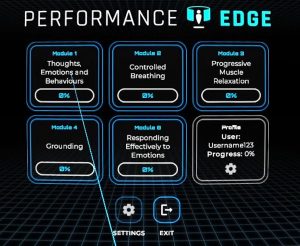
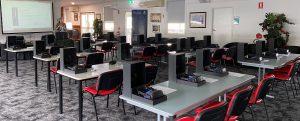
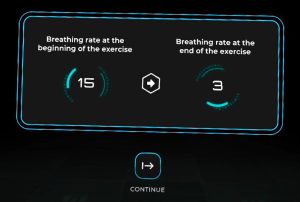
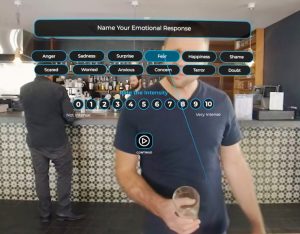
FRICS – Inner state monitoring and performance feedback in free roam combat training
Project Name: Free Roam Immersive Combat Simulation (FRICS)
Project Overview: The FRICS project aims to enhance current combat training practices by capturing real-time performance and biometrics data (e.g. heart rate) coupled with Free-Roam Virtual Reality (FRVR) as a training tool.
FRVR is a technology that allows users (individually or in groups / teams) to freely move un-tethered through a real-world space wearing a VR headset. Movement is then displayed accurately in a virtual space (e.g. combat scenario). Training in the FRVR environment allows for a greater depth of performance analysis and provides the opportunity to investigate the impact of the internal state and stress management skills on external performance.
Collaborator / Partners / Funding:
- Australian Defence Force
Primary ATS Project Officer(s) & Contact:
- Ann Stevenson (Ann.Stevenson@Newcastle.edu.au)
Relevant Links:

Cognitive Overload – Objective performance and monitoring for complex integrative real-time task-loading
Project Name: Biomarkers of cognitive overload
Project Overview: In the modern world, numerous civil and military occupations require making decisions under conditions of high cognitive demand. When a decision-maker can comfortably process information provided to them in a given time-frame, cognitive load is considered low. In contrast, as the amount of information increases or the time available decreases, cognitive load is increased. For every decision-maker, there is a critical point at which no further information can effectively be processed or considered. This situation is termed ‘cognitive overload’.
Our aim is to develop a non-obtrusive biomarker of cognitive overload. We propose that such biomarkers would be useful to allow monitoring of decision-makers and in reduce errors. We will combine continuous cognitive monitoring with advanced cardiovascular assessment during cognitive load testing using a system based on previous models developed by the US National Aeronautics & Space Administration (NASA).
Collaborators / Partners / Funding:
- A/Prof Ami Eidels & Prof Scott Brown, School of Psychology, University of Newcastle
- Prof Chin-Teng Lin, School of Computer Science & A/Prof Sara Lal, School of Life Sciences, University of Technology Sydney
- NSW Defence Innovation Network – funding
Primary ATS Project Officer(s) & Contact:
- A/Prof Eugene Nalivaiko (Eugene.Nalivaiko@newcastle.edu.au)
Relevant Links:
- https://www.newcastle.edu.au/profile/ami-eidels
- https://www.newcastle.edu.au/profile/scott-brown
- https://www.uts.edu.au/staff/chin-teng.lin
- https://www.uts.edu.au/staff/sara.lal
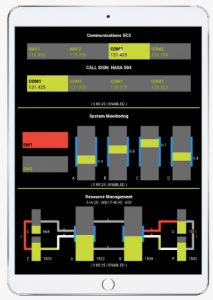
Cedar-OWAT – NASA-based cognitive load test comprising communication, system monitoring and resource management components
If you are interested in developing a specific training programme in collaboration with the Centre for Advanced Training Systems (ATS), we would like to hear from you. Please send us an email or access the Contact Us page to get in touch with our team.
Designing, Developing and Implementing Next Generation Training
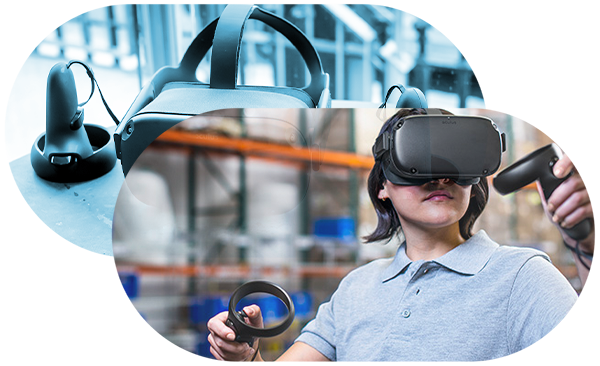
Learn About the Centre
The Centre for Advanced Training Systems brings together researchers, educators and technology experts to provide tailored end-to-end project management.
Learn About Specific Projects
The Centre for Advanced Training Systems (ATS) activities are funded on a project-specific basis and focus on improving workplace training in three main areas: Defence, Health and Education.
Learn About the Team
Our focus is on working with organisations to develop, implement and evaluate new training approaches that take advantage of digital platforms, particularly digital simulation platforms.
Mailing list signup
Join our mailing list to receive information on Centre updates and to be involved in testing of new applications.

